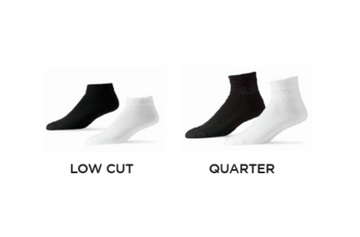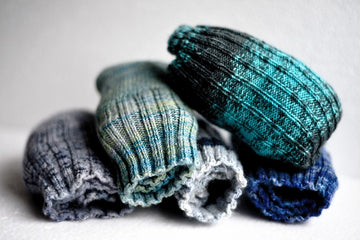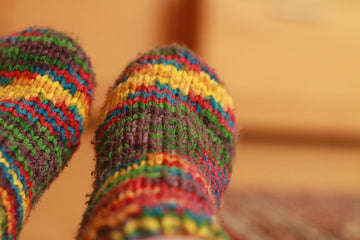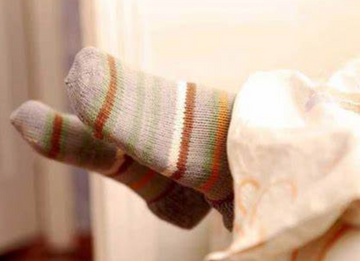
The world of socks can be surprisingly complex! Today we're diving into the debate between quarter socks and ankle socks. While they might seem like minor players, these sock lengths offer distinct advantages depending on your activity and personal style.
This guide explores the key differences between quarter socks and ankle socks, helping you choose the best option for your needs. We'll delve into their lengths, pros and cons, and who might find each style most suitable.
What Is a Quarter Size Sock?

Quarter-size socks, also known as quarter-length socks, typically measure around 6 inches in height. They extend right above the ankle and fall below the mid-calf region. These socks are designed to provide moderate coverage, offering protection and comfort without extending too far up the leg.
What Is an Ankle Sock?

An ankle sock is a type of sock that covers the entire foot and extends up to the ankle. Unlike crew socks, which are longer and typically reach mid-calf or higher, ankle socks provide shorter coverage that stops at or just above the ankle bone.
One of the key features of ankle socks is their discreet appearance when worn with shorts, capris, or other clothing items that expose the ankles. They sit right above or right below the shoe opening, minimizing their visibility and providing a clean and streamlined look.
Read More:

Shop Our Best Ankle Socks Collection
@thesockwave ♬ 原创音乐 - Eddie Bunny
Quarter Socks vs Ankle Socks
Quarter Socks vs Ankle Socks: Length

The main difference between quarter socks and ankle socks is their length.
Quarter socks
Quarter socks, also referred to as shorty socks or anklets, extend just above the ankle bone, providing more coverage than ankle socks but less than crew socks, which reach mid-calf length. Offering approximately 25% leg coverage, they strike a balance between the two extremes. This length allows for versatility, enabling you to display stylish designs or messages on the socks while still maintaining a degree of coverage. Quarter socks are a fun way to infuse personality into an outfit, often available in playful patterns. However, they may not be the optimal choice for activities that require minimal coverage or when wearing low-cut shoes.
Ankle Socks
Ankle socks rest snugly at the ankle bone or slightly above, offering minimal coverage. They are a favored option for low-cut shoes or when the weather turns warmer.
In contrast, ankle socks epitomize minimalism, barely visible above sneakers. This emphasis on comfort and functionality makes them a top choice for athletes prioritizing unrestricted movement. Their sleek design transitions seamlessly into running, cycling, or workout attire. Despite their practicality, ankle socks also boast style potential, especially when paired with flats or heels, showcasing unexpected versatility for any occasion.
Quarter Socks vs Ankle Socks: Pros and Cons
Quarter Socks
Pros
- Enhanced Coverage: The extended length of quarter socks provides more protection for your ankles against blisters and chafing, making them an excellent choice for those prone to discomfort during prolonged wear.
- Versatility: Suitable for various activities, including athletic pursuits, quarter socks are a versatile option for everyday wear. Whether you're running errands or hitting the gym, these socks offer reliable comfort and support.
- Secure Fit: Quarter socks are designed to stay put in most types of shoes, ensuring they remain in place throughout the day. This feature is particularly beneficial during physical activities, preventing the socks from slipping down and causing irritation.
Cons
- Increased Warmth: Due to their longer length, quarter socks may trap more heat than ankle socks, potentially leading to warmer feet in certain conditions. This aspect could be a drawback for individuals who prefer cooler footwear options.
- Visibility: While quarter socks offer more coverage, they may not be the most discreet choice for low-cut shoes, as they can peek out above the shoe collar. This visibility might not align with everyone's style preferences or certain dress codes.
Ankle Socks
Pros
- Improved Breathability: Ankle socks are cooler and more breathable than their quarter-length counterparts, making them ideal for warmer weather or intense physical activities where moisture-wicking properties are essential.
- Low Profile: With their shorter length, ankle socks are less noticeable when worn with low-cut shoes, providing a sleek and streamlined appearance. This aspect contributes to a cleaner aesthetic and may be preferred for certain fashion styles.
- Style Variety: Ankle socks offer a wider range of styles, colors, and designs compared to quarter socks, allowing wearers to express their personality and coordinate their socks with various outfits and footwear choices.
Cons
- Reduced Protection: The shorter length of ankle socks offers less coverage, potentially leaving the ankles more exposed to friction and discomfort during extended wear, particularly in athletic settings or when wearing new shoes.
- Slipping Risk: Ankle socks may have a tendency to slip out of certain shoe styles, such as loafers or slip-on sneakers, due to their shorter design. This can lead to annoyance and the need for readjustment throughout the day.
Ultimately, the choice between quarter socks and ankle socks depends on individual preferences, activity levels, and style considerations. Each option offers unique benefits and drawbacks, allowing wearers to select the most suitable option for their specific needs.
Quarter Socks vs Ankle Socks: Who Wears Quarter Socks?
Quarter socks are versatile and suitable for a wide range of individuals who prioritize comfort, style, and functionality in their footwear choices.
- Fashion-Conscious Individuals: Quarter socks offer a stylish compromise between ankle socks and crew socks, making them a popular choice for those who want to showcase some calf while maintaining a sleek and modern look.
- Active Individuals: Athletes and fitness enthusiasts may opt for quarter socks during workouts and physical activities. The added coverage helps protect against blisters and chafing, making them a practical choice for runners, cyclists, and gym-goers.
- Professionals: Quarter socks provide a professional appearance suitable for both formal and casual settings. They can be paired with dress shoes, loafers, or sneakers, making them a versatile option for the workplace or social events.
- People Who Dislike Sock Slippage: Quarter socks offer a secure fit that minimizes slippage, making them ideal for individuals who find traditional ankle socks prone to slipping down throughout the day.
- Those Who Prefer Moderate Coverage: Some individuals may find crew socks too long or ankle socks too short. Quarter socks provide a mid-sized option that offers just the right amount of coverage for their comfort and style preferences.
Overall, quarter socks appeal to a diverse range of wearers, offering a balance of comfort, style, and practicality for various occasions and lifestyles.
Quarter Socks vs Ankle Socks: Who Wears Ankle Socks?
Ankle socks are worn by a wide range of individuals for various reasons.
- Athletes: Ankle socks are popular among athletes, including runners, basketball players, and tennis players. The shorter length of ankle socks provides freedom of movement and allows for better airflow, which can be beneficial during intense physical activity.
- Casual Wearers: Many people choose ankle socks for everyday wear due to their comfort and versatility. They are suitable for pairing with sneakers, loafers, sandals, and other casual footwear styles.
- Warm Weather Enthusiasts: In hot climates or during the summer months, ankle socks offer a cooler alternative to longer sock styles. The shorter length helps prevent overheating and allows the feet to breathe more easily.
- Fashionistas: Ankle socks have become a fashion statement in recent years, with various colors, patterns, and designs available. Fashion-conscious individuals may wear ankle socks to add a pop of color or pattern to their outfit or to create a trendy, layered look.
- Individuals with Footwear Preferences: Some people prefer the aesthetic of low-cut shoes, such as sneakers or loafers, and choose ankle socks to complement these styles. Ankle socks provide a seamless look that doesn't detract from the overall appearance of the shoes.
- Individuals with Ankle Injuries: While not directly related to wearing ankle socks, individuals with ankle injuries may benefit from wearing ankle braces for support and stability during the recovery process. Ankle socks can be worn comfortably under ankle braces to provide an additional layer of cushioning and protection.
Overall, ankle socks are a versatile and practical choice for a wide range of individuals, offering comfort, style, and functionality for various activities and preferences.
Are Low-Cut and Quarter Socks the Same?
Low-cut socks and quarter socks are similar in that they both provide shorter coverage compared to crew socks, but they differ slightly in length and coverage area.
Low-cut socks typically have a modest rise above the shoe's heel collar and usually stop at the middle of the anklebone. They offer minimal coverage and are designed to be discreet, making them a popular choice for wearing with low-cut shoes or for a minimalist look.
Quarter socks, on the other hand, rise slightly higher than low-cut socks, usually covering the anklebone entirely. They provide a bit more coverage and protection, particularly around the ankle area. Quarter socks are often worn by runners who experience heel blistering resulting from shoe friction, as the extra coverage helps prevent irritation and discomfort.
What Is the Difference Between Crew Socks and Ankle Socks?
The main difference between crew socks and ankle socks lies in their length and coverage.
Length
Crew socks typically come up about 6-8 inches on the leg, extending from the heel to mid-calf. They offer more coverage compared to ankle socks.
Ankle socks, on the other hand, hit right at the ankle bone, providing minimal coverage that stops just above the shoe opening.
Coverage
Crew socks cover a larger portion of the leg, providing warmth and protection to the lower calf area. They are often preferred for colder weather or activities where extra coverage is desired.
Ankle socks offer a more minimalist look, providing coverage only up to the ankle bone. They are popular for warmer weather, athletic activities, and wearing with low-cut shoes where minimal coverage is preferred.
What Is the Difference Between No Show and Ankle Socks?
The primary difference between no-show socks and ankle socks lies in their length and visibility.
Length
No-show socks, as the name suggests, are designed to remain invisible or hidden even when worn with low-cut shoes like loafers or boat shoes. They typically cover only the foot and do not extend past the shoe opening. No-show socks offer minimal coverage, stopping below the ankle bone.
Ankle socks, on the other hand, cover the entire forefoot and extend up to the ankles. They provide more coverage compared to no-show socks, reaching above the ankle bone for additional protection and warmth.
Visibility
No-show socks are intended to be discreet and remain hidden under shoes, giving the appearance of bare feet. They are ideal for achieving a sockless look while still providing a barrier between the foot and the shoe.
Ankle socks, by contrast, are more visible as they cover a larger portion of the foot and extend above the ankle bone. They are typically worn with shoes that have a higher cut or when some coverage above the ankle is desired.
Are Ankle Socks Formal?
Ankle socks can indeed be worn with formal shoes, but it's crucial to consider several factors to ensure they maintain a formal appearance.
- Color
Opt for ankle socks that match the color of your trousers or shoes to create a cohesive and polished look. Neutral colors like black, navy, or gray are typically safe choices for formal occasions.
- Material
Choose ankle socks made of high-quality materials such as cotton, wool, silk, or nylon. These materials offer comfort, breathability, and durability, enhancing the overall appearance of the outfit.
- Thickness
Select ankle socks with a moderate thickness that provides sufficient coverage without adding bulk. Thin socks are preferable for formal wear as they create a sleek and refined silhouette.
- Length
Ensure that the ankle socks cover the entire foot and sit just above the ankle bone. Avoid socks that are too short or too long, as they may disrupt the formal aesthetic of the outfit.
- Style
Stick to classic and understated designs when choosing ankle socks for formal occasions. Avoid patterns or embellishments that may detract from the overall elegance of the ensemble.
By paying attention to these details, you can successfully incorporate ankle socks into formal attire while maintaining a sophisticated and polished appearance.
Final Thoughts
Ultimately, the choice between quarter socks and ankle socks boils down to personal preference, comfort, and the occasion. Whether you prioritize coverage, breathability, or a touch of personality, both styles offer unique benefits. So, stock up on your favorites and embrace the power of the perfect sock choice!
Read More:







